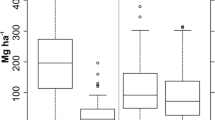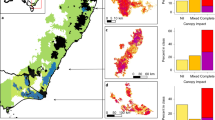Abstract
Wildfire activity is projected to increase through upcoming decades in boreal Canada due to climatic changes. Amongst the proposed strategies to offset the climate-driven fire risk is the introduction of broadleaf species into dense-coniferous landscapes so as to decrease the intensity and rate of spread of future wildfires. Here we examine this offsetting potential through boreal Canada by searching for optimal conifer to broadleaf conversion rates that would stabilize the burn rate metric, and an upper bound for the maximum potential effect. We developed an empirical model relating regional burn rates to mean annual fire weather conditions and tree genus proportions, and applied it to regional climate and forest composition change scenarios covering the interval from 1971 to 2100. Results suggested that many areas in the southern and northern boreal regions will record either a constant or a decreasing burn rate and, therefore, will not require a change of forest composition. Besides, a conversion rate of 0.1 to 0.2 % year−1 starting in year 2020 was sufficient to maintain burn rates constant across much of the southern boreal forest. In northern forests, however, higher conversion rates were required to meet the fire objectives (0.3 to 0.4 % year−1). This mitigation option will be difficult to implement over northern forests given the size of areas involved. Nonetheless the estimated conversion rate for much of the southern boreal forest is attainable, considering that harvesting and industrialization during recent decades have already contributed to similar changes of the proportion of broadleaf species in boreal landscapes.




Similar content being viewed by others
References
Alexander ME (2010) Surface fire spread potential in trembling aspen during summer in the Boreal Forest Region of Canada. For Chron 86:200–212. doi:10.5558/tfc86200-2
Amiro BD, Stocks BJ, Alexander ME, Flannigan MD, Wotton BM (2001) Fire, climate change, carbon and fuel management in the Canadian boreal forest. Int J Wildland Fire 10:405–413. doi:10.1071/WF01038
Barrett K, McGuire AD, Hoy EE, Kasischke ES (2011) Potential shifts in dominant forest cover in interior Alaska driven by variations in fire severity. Ecol Appl 21:2380–2396. doi:10.1890/10-0896.1
Beaudoin A, Bernier PY, Guindon L, Villemaire P, Guo XJ, Stinson G, Bergeron T, Magnussen S, Hall RJ (2014) Mapping attributes of Canada’s forests at moderate resolution through kNN and MODIS imagery. Can J For Res 44:521–532. doi:10.1139/cjfr-2013-0401
Boiffin J, Munson AD (2013) Three large fire years threaten resilience of closed crown black spruce forests in eastern Canada. Ecosphere 4(5):art56
Boisvert-Marsh L, Périé C, de Blois S (2014) Shifting with climate? Evidence for recent changes in tree species distribution at high latitudes. Ecosphere 5:art83. doi:10.1890/ES14-00111.1
Boulanger Y, Gauthier S, Burton PJ (2014) A refinement of models projecting future Canadian fire regimes using homogeneous fire regime zones. Can J For Res 44:365–376. doi:10.1139/cjfr-2013-0372
Brown JK, DeByle NV (1987) Fire damage, mortality, and suckering in aspen. Can J For Res 17:1100–1109. doi:10.1139/x87-168
Brown JK, Giesecke T (2014) Holocene fire disturbance in the boreal forest of central Sweden. Boreas 43:639–651. doi:10.1111/bor.12056
Canadian Committee on Forest Management (2012) National Forestry Database. [online] Available from: http://nfdp.ccfm.org/. Accessed 9 Dec 2014
Chen HYH, Vasiliauskas S, Kayahara GJ, Ilisson T (2009) Wildfire promotes broadleaves and species mixture in boreal forest. For Ecol Manag 257:343–350. doi:10.1016/j.foreco.2008.09.022
de Elía R, Côté H (2010) Climate and climate change sensitivity to model configuration in the Canadian RCM over North America. Meteorol Z 19:325–339. doi:10.1127/0941-2948/2010/0469
de Groot WJ, Flannigan MD, Cantin AS (2013) Climate change impacts on future boreal fire regimes. For Ecol Manag 294:35–44. doi:10.1016/j.foreco.2012.09.027
Environment Canada (2013) National Climate Data and Information Archive. http://climate.weatheroffice.gc.ca/
Flannigan MD, Cantin AS, de Groot WJ, Wotton M, Newbery A, Gowman LM (2013) Global wildland fire season severity in the 21st century. For Ecol Manag 294:54–61
Francis JA, Vavrus SJ (2012) Evidence linking Arctic amplification to extreme weather in mid-latitudes. Geophys Res Lett 39, L06801. doi:10.1029/ 2012GL051000
Friedman JH (1991) Multivariate adaptive regression splines. Ann Stat 19:1–67
Gauthier S, Vaillancourt M-A, Leduc A, De Grandpré L, Kneeshaw DD, Morin H, Drapeau P, Bergeron Y (2009) Ecosystem management in the boreal forest. Les Presses de l’Université du Québec, Québec
Gauthier S, Raulier F, Ouzennou H, Saucier J-P (2015) Strategic analysis of forest vulnerability to risk related to fire: example of the resinous boreal forest of Québec. Can J For Res
Gillett NP, Weaver AJ, Zwiers FW, Flannigan MD (2004) Detecting the effect of climate change on Canadian forest fires. Geophys Res Lett 31, L18211. doi:10.1029/2004GL020876
Girardin MP, Ali AA, Carcaillet C, Blarquez O, Hély C, Terrier A, Genries A, Bergeron Y (2013) Vegetation limits the impact of a warm climate on boreal wildfires. New Phytol 199:1001–1011. doi:10.1111/nph.12322
Grondin P, Bélanger L, Roy V, Noël J, Hotte D (2003) Envahissement des parterres de coupe par les feuillus de lumière (enfeuillement). In P. Grondin and A. Cimon (coordonnateurs). Les enjeux de biodiversité relatifs à la composition forestière. Ministère des Ressources naturelles, de la Faune et des Parcs du Québec, Québec, pp 131–174
Guindon L, Bernier PY, Beaudoin A, Pouliot D, Villemaire P, Hall RJ, Latifovic R, St-Amant R (2014) Annual mapping of severe forest disturbances across Canada’s forests using 250 m MODIS imagery from 2000 to 2011. Can J For Res
Hanberry BB, Palik BJ, He HS (2012) Comparison of historical and current forest surveys for detection of homogenization and mesophication of Minnesota forests. Landsc Ecol 27:1495–1512. doi:10.1007/s10980-012-9805-5
Harden JW, Trumbore SE, Stocks BJ, Hirsch A, Gower ST, O’Neill JP, Kasischke ES (2000) The role of fire in the boreal carbon budget. Glob Chang Biol 6:174–184. doi:10.1046/j.1365-2486.2000.06019
Héon J, Arseneault D, Parisien MA (2014) Resistance of the boreal forest to high burn rates. Proc Natl Acad Sci U S A 111:13888–13893. doi:10.1073/pnas.1409316111
Hirsch K, Kafka V, Todd B (2004) Using forest management techniques to alter forest fuels and reduce wildfire size: an exploratory analysis. In: Engstrom RT, Galley KEM, de Groot WJ (eds) Fire in temperate, boreal, and montane ecosystems. Tall Timber Research Station, Tallahassee, FL, pp 175–184
Iverson LR, Prasad AM (1998) Predicting abundance of 80 tree species following climate change in the eastern United States. Ecol. Monogr. 68:465–485. doi:10.1890/0012-9615 DOI:10.1890/0012-9615(1998)068%5b0465:PAOTSF%5d2.0.CO;2
Johnson EA (1992) Fire and vegetation dynamics. Studies from the North American boreal forest. Cambridge Studies in Ecology. University Press, Cambridge, p 129
Johnstone JF, Chapin FS III (2006) Effects of soil burn severity on post-fire tree recruitment in boreal forest. Ecosystems 9:14–31. doi:10.1007/s10021-004-0042-x
Johnstone JF, Hollingsworth TN, Chapin FS, Mack MC (2010) Changes in fire regime break the legacy lock on successional trajectories in Alaskan boreal forest. Glob Chang Biol 16:1281–1295. doi:10.1111/j.1365-2486.2009.02051
Kelly R, Chipman ML, Higuera PE, Stefanova I, Brubaker LB, Hu FS (2013) Recent burning of boreal forests exceeds fire regime limits of the past 10,000 years. Proc Natl Acad Sci U S A 110:13055–13060. doi:10.1073/pnas.1305069110
Krawchuk MA, Cumming SG (2011) Effects of biotic feedback and harvest management on boreal forest fire activity under climate change. Ecol Appl 21:122–136. doi:10.1890/09-2004.1
Landhäusser SM, Deshaies D, Lieffers VJ (2010) Disturbance facilitates rapid range expansion of aspen into higher elevations of the Rocky Mountains under a warming climate. J Biogeogr 37:68–76. doi:10.1111/j.1365-2699.2009.02182.x
Laquerre S, Harvey BD, Leduc A (2011) Spatial analysis of response of trembling aspen patches to clearcutting in black spruce-dominated stands. For Chron 87:77–85. doi:10.5558/tfc87077-1
Legendre P (2011) const.clust: space- and time-constrained clustering package. R package version 1.2. Récupéré de http://numericalecology.com/rcode
Legendre P, Legendre L (2012) Numerical ecology (Vol. 20). Elsevier
Mansuy N, Gauthier S, Bergeron Y (2013) Afforestation opportunities when stand productivity is driven by a high risk of natural disturbance: a review of the open lichen woodland in the eastern boreal forest of Canada. Mitig Adapt Strateg Glob Chang 18:245–264. doi:10.1007/s11027-012-9362-x
McKenney DW, Pedlar JH, Rood RB, Price D (2011) Revisiting projected shifts in the climate envelopes of North American trees using updated general circulation models. Glob Chang Biol 17:2720–2730. doi:10.1111/j.1365-2486.2011.02413.x
Nowacki GJ, Abrams MD (2014) Is climate an important driver of post-European vegetation change in the Eastern United States? Glob Chang Biol. doi:10.1111/gcb.12663
O’ishi R, Abe-Ouchi A (2009) Influence of dynamic vegetation on climate change arising from increasing CO2. Clim Dyn 33:645–663. doi:10.1007/s00382-009-0611-y
PAGES 2k Consortium (2013) Continental-scale temperature variability during the past two millennia. Nat Geosci 6:339–346. doi:10.1038/NGEO1797
Pinto F, Romaniuk S, Ferguson M (2008) Changes to preindustrial forest tree composition in central and northeastern Ontario. Can Can J For Res 38:1842–1854. doi:10.1139/X08-034
R Development Core Team (2010) R: a language and environment for statistical computing. R Foundation for Statistical Computing, Vienna
Régnière J, Bolstad P (1994) Statistical simulation of daily air temperature patterns in eastern North America to forecast seasonal events in insect pest management. Environ Entomol 23:1368–1380
Rupp TS, Olson M, Adams LG, Dale BW, Joly K, Henkelman J, Collins WB, Starfield AM (2006) Simulating the influences of various fire regimes on caribou winter habitat. Ecol. Appl. 16:1730–1743. doi:10.1890/1051-0761 DOI:10.1890/1051-0761(2006)016%5b1730:STIOVF%5d2.0.CO;2
Salford Systems (2013) MARS v7.0. Salford Systems, San Diego
Shenoy A, Johnstone JF, Kasischke ES, Kielland K (2011) Persistent effects of fire severity on early successional forests in interior Alaska. Forest Ecol Manag 261:381–390. doi:10.1016/j.foreco.2010.10.021
Taylor SW, Pike RG, Alexander M (1996) Field Guide for the Canadian Forest Fire Behavior Prediction System. Nat. Resour. Can., Can. For. Serv. Pacific Forestry Centre, Victoria
Terrier A, Girardin MP, Périé C, Legendre P, Bergeron Y (2013) Potential changes in forest composition could reduce impacts of climate change on boreal wildfires. Ecol Appl 23:21–35. doi:10.1890/12-0425.1
Terrier A, Girardin MP, Cantin, A, de Groot WJ, Anyomi, KA, Gauthier S, Bergeron Y (2015) Disturbance legacies and paludification mediate the ecological impact of an intensifying wildfire regime in the Clay Belt boreal forest of eastern North America. J. Veg. Sci
Van Vuuren DP, Edmonds J, Kainuma M, Riahi K, Thomson A, Hibbard K, Hurtt GC, Kram T, Krey V, Lamarque J-F, Masui T, Meinshausen M, Nakicenovic N, Smith SJ, Rose SK (2011) The representative concentration pathways: an overview. Clim Chang 109:5–31. doi:10.1007/s10584-011-0148-z
Van Wagner CE (1983) Fire behaviour in northern conifer forests and shrublands. In: Wein RW, MacLean DA (eds) The role of fire in northern circumpolar ecosystems. SCOPE 18. Wiley, New York, pp 65–80
Van Wagner CE (1987) Development and structure of the Canadian forest fire weather index system, Forestry Technical Report 35. Can. For. Serv, Ottawa
Wang X, Parisien M-A, Flannigan MD, Parks SA, Anderson KR, Little JM, Taylor SW (2014) The potential and realized spread of wildfires across Canada. Glob Chang Biol 20:2518–2530. doi:10.1111/gcb.12590
Wotton BM, Nock CA, Flannigan MD (2010) Forest fire occurrence and climate change in Canada. Int J Wildland Fire 19:253–271. doi:10.1071/WF09002
Acknowledgments
This project was financially supported by the Canadian Forest Service (Natural Resources Canada) and the Natural Sciences and Engineering Research Council of Canada (NSERC; Discovery Grant allocated to M.P. Girardin). We thank Rémi Saint-Amant (Natural Resources Canada) for providing the climate data generated by BioSIM. The CanRCM4 data were supplied by the Canadian Centre for Climate Modelling and Analysis. We extend our thanks to Pierre Grondin, Luc Guindon, Dan McKenney and four anonymous reviewers for helpful comments and to Pamela Cheers for technical editing.
Author information
Authors and Affiliations
Corresponding author
Additional information
Martin P. Girardin and Aurélie Terrier contributed equally to this work.
Electronic supplementary material
Below is the link to the electronic supplementary material.
ESM 1
(DOCX 2044 kb)
Rights and permissions
About this article
Cite this article
Girardin, M.P., Terrier, A. Mitigating risks of future wildfires by management of the forest composition: an analysis of the offsetting potential through boreal Canada. Climatic Change 130, 587–601 (2015). https://doi.org/10.1007/s10584-015-1373-7
Received:
Accepted:
Published:
Issue Date:
DOI: https://doi.org/10.1007/s10584-015-1373-7




